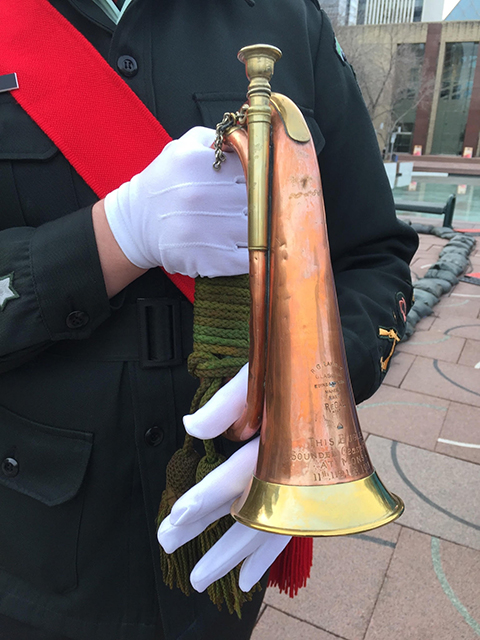Cenotaph Rededication Ceremony
Marking the 20th anniversary of Canada's entrance into the War in Afghanistan (2001—2014), the City Hall Cenotaph was rededicated on June 13, 2021, in honour of the military personnel who served in this conflict.
Street sweeping parking bans run Monday to Friday from 7am to 5pm in scheduled areas. Find your neighbourhood schedule and sign up for notifications.
Main page content begins here
Standing solemnly on the City Hall Plaza, the Edmonton Cenotaph was erected in memory of those who sacrificed their lives as a result of World War I (1914-1918), World War II (1939-1945), the Korean War (1950–1953), and the Afghanistan War (2001–2014).
Organized in 1935, Edmonton’s Citizens Cenotaph Committee had representatives from 32 local organizations, including:
The Cenotaph was erected the following year, and on August 13, 1936, it was unveiled by Lord Tweedsmuir, Governor General of Canada.
Originally located at 102 Street and 100 Avenue, the Cenotaph was moved to the City Hall Plaza in 1978.
The Cenotaph is constructed of concrete, steel, and marble imported from British Columbia. It has a total weight of more than 100 tons. The base is 18 feet square and 12 feet deep and was reinforced with streetcar rails. The platform rests on 12 concrete piles, each 8 feet deep, which are also reinforced with steel rails. The Cenotaph stands 23 feet high.
A number of dedications have taken place over the years, with additional engravings memorializing the men and women who served in conflicts, including the Second World War (dedication 1946), the Korean War (dedication 1956), and various Canadian peacekeeping missions.
For centuries, military bugle calls were used to issue orders in battle and within garrison routine. The Mons Bugle was played at the World War I Armistice Ceremony in Mons, Belgium, on November 11, 1918. It was separated from its Regiment for decades and was later discovered and brought to its rightful home at the Loyal Edmonton Regiment Museum. It can be viewed at the Prince of Wales Armoury.
The historic Mons Bugle, the bugle that signalled the end of World War I at Mons, Belgium, will be used in the rededication ceremony.

Spanning many centuries, regiments would use bugles, drums and colours (flag-like devices) to effect signals regarding battlefield maneuvers. In time, battle honours would be emblazoned on regimental colours and drums. Both would become revered, reflecting a regiment’s bloodline and most significant wartime achievements – at immense personal sacrifice.
Eventually, piling the drums would be used for memorials and non-denominational church services in the field often near the battlefront, operational deployments and on lengthy training exercises. Piling the drums would provide for an improvised generic alter, as a focal point. Often regimental colours would be draped over the regimental drums.
The Loyal Edmonton Regiment has kindly provided their Regimental Drums in honour of all those that have sacrificed. COVID restrictions have made the use of a Colour Party or a National Flag Party untenable.
Canada fought in the War in Afghanistan from October 2001 to March 2014. It was our nation’s longest war. More than 40,000 Canadian Armed Forces members served in the 12-year campaign. 158 Canadian soldiers died during the Afghanistan mission. Thousands of other veterans of the war were wounded, physically and psychologically, leading to additional deaths by suicide.